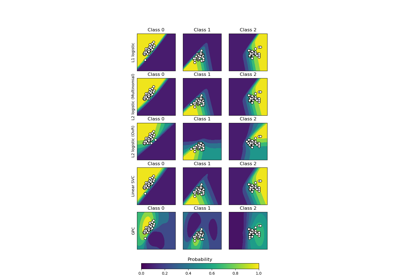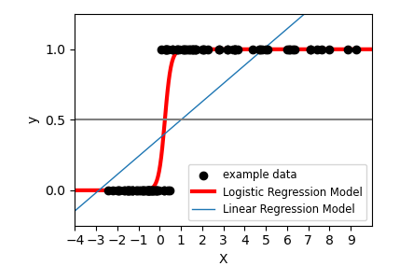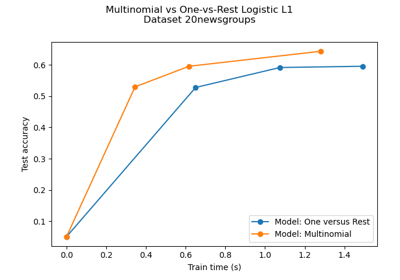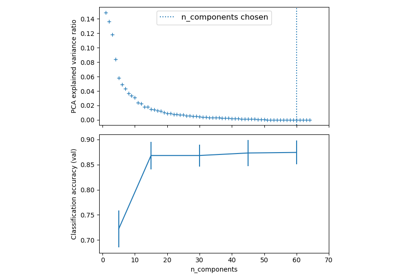注意
转到末尾 下载完整示例代码。或通过 JupyterLite 或 Binder 在您的浏览器中运行此示例
受限玻尔兹曼机特征用于数字分类#
对于像素值可解释为白色背景上黑色程度的灰度图像数据,例如手写数字识别,伯努利受限玻尔兹曼机模型 (BernoulliRBM) 可以执行有效的非线性特征提取。
# Authors: The scikit-learn developers
# SPDX-License-Identifier: BSD-3-Clause
生成数据#
为了从小型数据集中学习良好的潜在表示,我们通过在每个方向上对训练数据进行 1 像素的线性位移扰动来人工生成更多带标签的数据。
import numpy as np
from scipy.ndimage import convolve
from sklearn import datasets
from sklearn.model_selection import train_test_split
from sklearn.preprocessing import minmax_scale
def nudge_dataset(X, Y):
"""
This produces a dataset 5 times bigger than the original one,
by moving the 8x8 images in X around by 1px to left, right, down, up
"""
direction_vectors = [
[[0, 1, 0], [0, 0, 0], [0, 0, 0]],
[[0, 0, 0], [1, 0, 0], [0, 0, 0]],
[[0, 0, 0], [0, 0, 1], [0, 0, 0]],
[[0, 0, 0], [0, 0, 0], [0, 1, 0]],
]
def shift(x, w):
return convolve(x.reshape((8, 8)), mode="constant", weights=w).ravel()
X = np.concatenate(
[X] + [np.apply_along_axis(shift, 1, X, vector) for vector in direction_vectors]
)
Y = np.concatenate([Y for _ in range(5)], axis=0)
return X, Y
X, y = datasets.load_digits(return_X_y=True)
X = np.asarray(X, "float32")
X, Y = nudge_dataset(X, y)
X = minmax_scale(X, feature_range=(0, 1)) # 0-1 scaling
X_train, X_test, Y_train, Y_test = train_test_split(X, Y, test_size=0.2, random_state=0)
模型定义#
我们构建了一个分类流水线,其中包含 BernoulliRBM 特征提取器和 LogisticRegression 分类器。
from sklearn import linear_model
from sklearn.neural_network import BernoulliRBM
from sklearn.pipeline import Pipeline
logistic = linear_model.LogisticRegression(solver="newton-cg", tol=1)
rbm = BernoulliRBM(random_state=0, verbose=True)
rbm_features_classifier = Pipeline(steps=[("rbm", rbm), ("logistic", logistic)])
训练#
整个模型的超参数(学习率、隐藏层大小、正则化)通过网格搜索进行优化,但由于运行时限制,此处不重现该搜索过程。
from sklearn.base import clone
# Hyper-parameters. These were set by cross-validation,
# using a GridSearchCV. Here we are not performing cross-validation to
# save time.
rbm.learning_rate = 0.06
rbm.n_iter = 10
# More components tend to give better prediction performance, but larger
# fitting time
rbm.n_components = 100
logistic.C = 6000
# Training RBM-Logistic Pipeline
rbm_features_classifier.fit(X_train, Y_train)
# Training the Logistic regression classifier directly on the pixel
raw_pixel_classifier = clone(logistic)
raw_pixel_classifier.C = 100.0
raw_pixel_classifier.fit(X_train, Y_train)
[BernoulliRBM] Iteration 1, pseudo-likelihood = -25.57, time = 0.08s
[BernoulliRBM] Iteration 2, pseudo-likelihood = -23.68, time = 0.12s
[BernoulliRBM] Iteration 3, pseudo-likelihood = -22.88, time = 0.12s
[BernoulliRBM] Iteration 4, pseudo-likelihood = -21.91, time = 0.12s
[BernoulliRBM] Iteration 5, pseudo-likelihood = -21.79, time = 0.12s
[BernoulliRBM] Iteration 6, pseudo-likelihood = -20.96, time = 0.12s
[BernoulliRBM] Iteration 7, pseudo-likelihood = -20.88, time = 0.11s
[BernoulliRBM] Iteration 8, pseudo-likelihood = -20.50, time = 0.11s
[BernoulliRBM] Iteration 9, pseudo-likelihood = -20.34, time = 0.11s
[BernoulliRBM] Iteration 10, pseudo-likelihood = -20.21, time = 0.11s
评估#
from sklearn import metrics
Y_pred = rbm_features_classifier.predict(X_test)
print(
"Logistic regression using RBM features:\n%s\n"
% (metrics.classification_report(Y_test, Y_pred))
)
/home/circleci/project/sklearn/metrics/_classification.py:1706: UndefinedMetricWarning:
Precision is ill-defined and being set to 0.0 in labels with no predicted samples. Use `zero_division` parameter to control this behavior.
/home/circleci/project/sklearn/metrics/_classification.py:1706: UndefinedMetricWarning:
Precision is ill-defined and being set to 0.0 in labels with no predicted samples. Use `zero_division` parameter to control this behavior.
/home/circleci/project/sklearn/metrics/_classification.py:1706: UndefinedMetricWarning:
Precision is ill-defined and being set to 0.0 in labels with no predicted samples. Use `zero_division` parameter to control this behavior.
Logistic regression using RBM features:
precision recall f1-score support
0 0.10 1.00 0.18 174
1 0.00 0.00 0.00 184
2 0.00 0.00 0.00 166
3 0.00 0.00 0.00 194
4 0.00 0.00 0.00 186
5 0.00 0.00 0.00 181
6 0.00 0.00 0.00 207
7 0.00 0.00 0.00 154
8 0.00 0.00 0.00 182
9 0.00 0.00 0.00 169
accuracy 0.10 1797
macro avg 0.01 0.10 0.02 1797
weighted avg 0.01 0.10 0.02 1797
Y_pred = raw_pixel_classifier.predict(X_test)
print(
"Logistic regression using raw pixel features:\n%s\n"
% (metrics.classification_report(Y_test, Y_pred))
)
/home/circleci/project/sklearn/metrics/_classification.py:1706: UndefinedMetricWarning:
Precision is ill-defined and being set to 0.0 in labels with no predicted samples. Use `zero_division` parameter to control this behavior.
/home/circleci/project/sklearn/metrics/_classification.py:1706: UndefinedMetricWarning:
Precision is ill-defined and being set to 0.0 in labels with no predicted samples. Use `zero_division` parameter to control this behavior.
/home/circleci/project/sklearn/metrics/_classification.py:1706: UndefinedMetricWarning:
Precision is ill-defined and being set to 0.0 in labels with no predicted samples. Use `zero_division` parameter to control this behavior.
Logistic regression using raw pixel features:
precision recall f1-score support
0 0.10 1.00 0.18 174
1 0.00 0.00 0.00 184
2 0.00 0.00 0.00 166
3 0.00 0.00 0.00 194
4 0.00 0.00 0.00 186
5 0.00 0.00 0.00 181
6 0.00 0.00 0.00 207
7 0.00 0.00 0.00 154
8 0.00 0.00 0.00 182
9 0.00 0.00 0.00 169
accuracy 0.10 1797
macro avg 0.01 0.10 0.02 1797
weighted avg 0.01 0.10 0.02 1797
BernoulliRBM 提取的特征有助于提高相对于原始像素上的逻辑回归的分类准确性。
绘图#
import matplotlib.pyplot as plt
plt.figure(figsize=(4.2, 4))
for i, comp in enumerate(rbm.components_):
plt.subplot(10, 10, i + 1)
plt.imshow(comp.reshape((8, 8)), cmap=plt.cm.gray_r, interpolation="nearest")
plt.xticks(())
plt.yticks(())
plt.suptitle("100 components extracted by RBM", fontsize=16)
plt.subplots_adjust(0.08, 0.02, 0.92, 0.85, 0.08, 0.23)
plt.show()
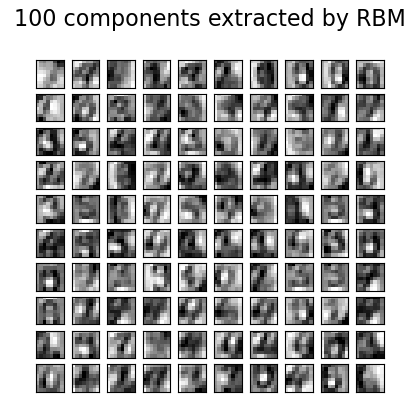
脚本总运行时间:(0 分 2.439 秒)
相关示例

